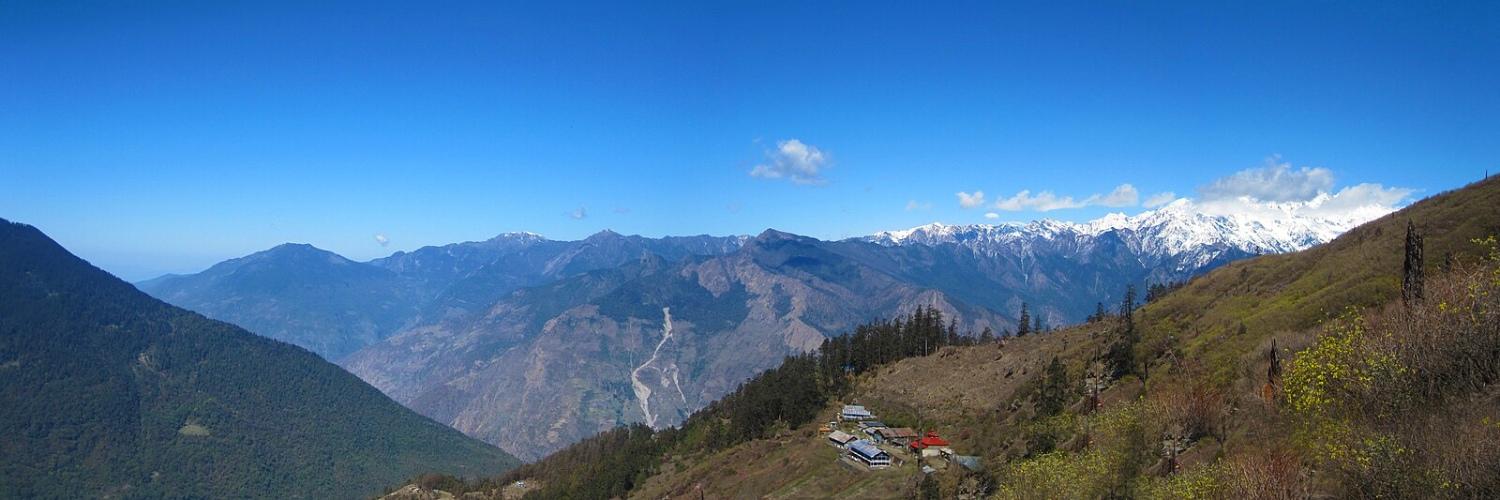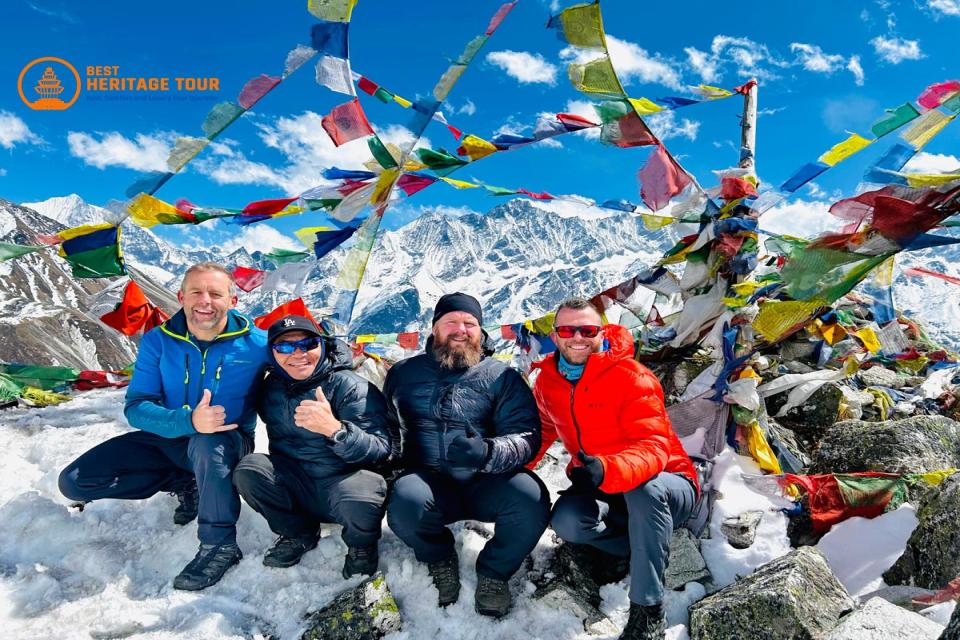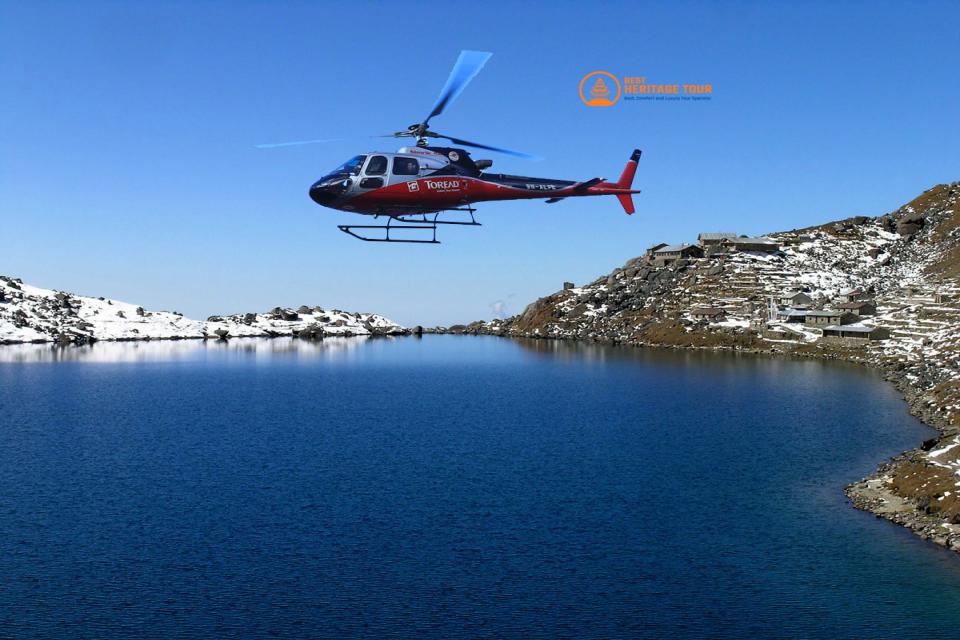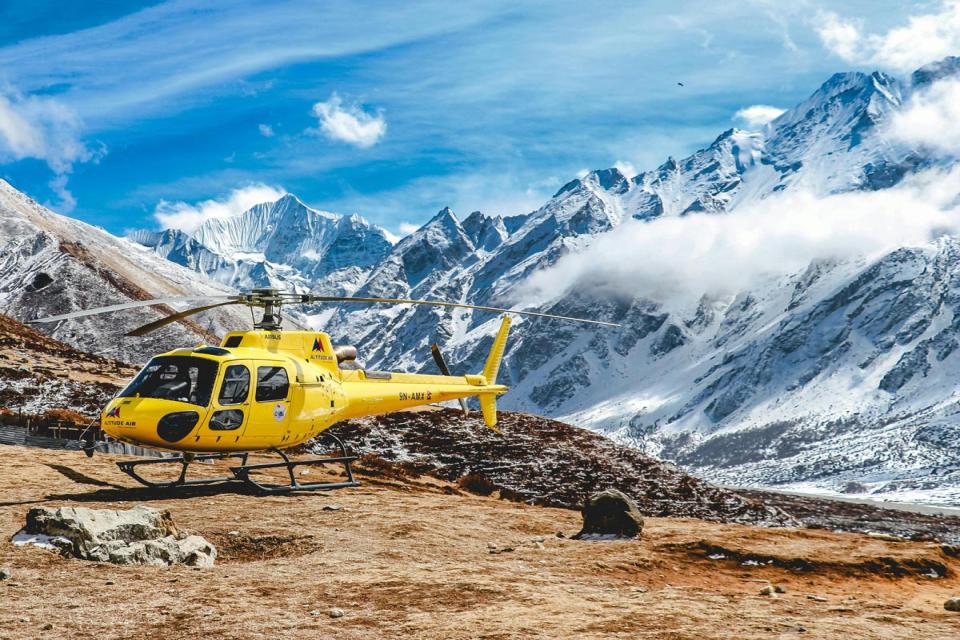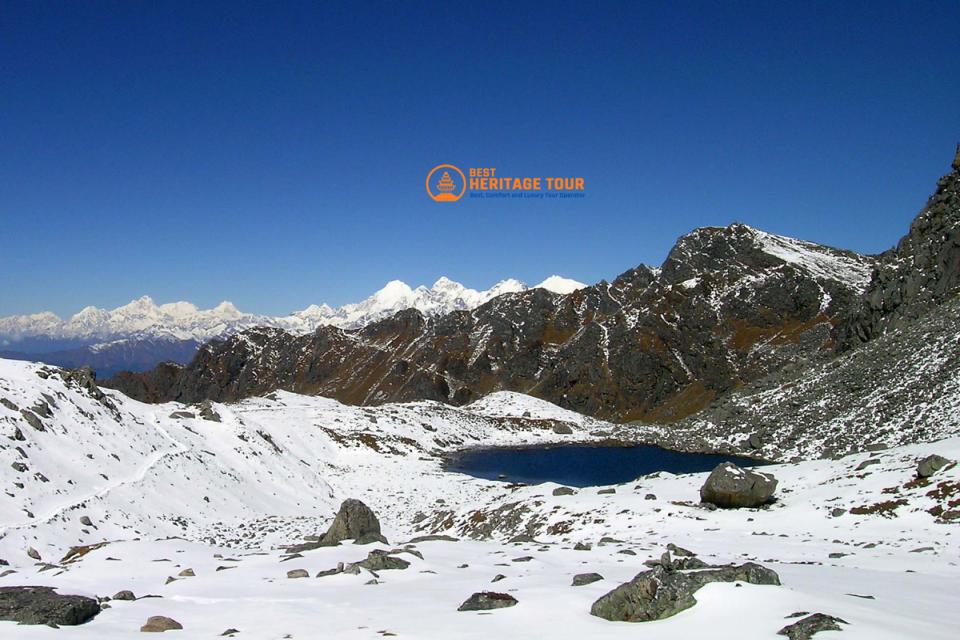Tucked away high in the Himalayas, Gosaikunda is one of Nepal’s most sacred and visually striking high-altitude lakes. Revered by both Hindus and Buddhists, this shimmering glacial lake is more than just a destination; it's a spiritual and trekking pilgrimage. But for many, the first question remains: Where is Gosaikunda located?
This blog offers a comprehensive guide to Gosaikunda’s location, including how to get there, the geography that defines it, its religious significance, and why it’s a must-visit for adventurers and pilgrims alike.
Where is Gosaikunda Located Geographically?
Gosaikunda is located in Rasuwa District, part of Bagmati Province in central Nepal. It lies within the boundaries of Langtang National Park, one of Nepal's first Himalayan conservation areas. Geographically, Gosaikunda is situated to the north of Kathmandu, roughly 140 kilometers away by road.
- Coordinates: 28.0833° N, 85.4167° E
- Altitude: Approx. 4,380 meters (14,370 feet)
This sacred alpine lake sits nestled among rugged ridgelines and is typically frozen during the winter months. Gosaikunda is one of over 100 high-altitude lakes in the region, but it remains the most significant due to its mythological, ecological, and trekking importance.
Gosaikunda on the Map: National and Regional Context
If you're looking at a map of Nepal, you’ll find Gosaikunda just south of the Langtang Himal range and northeast of Dhunche, the administrative center of Rasuwa District. It lies:
- Inside Langtang National Park, a protected area known for red pandas, Himalayan thars, and alpine forests.
- Along the Gosaikunda Trek route, which connects with both the Langtang Valley Trek and the Helambu region via Lauribina La Pass (4,610 m).
In terms of administrative boundaries:
- Country: Nepal
- Province: Bagmati Province
- District: Rasuwa
- Nearest Town: Dhunche (around 30 km trekking distance from Gosaikunda)
Gosaikunda’s Sacred Significance
To understand why people ask, “Where is Gosaikunda located?” you must understand why it is so revered.
-
In Hindu Mythology: According to legend, Lord Shiva created Gosaikunda by thrusting his trident into the mountains to cool his burning throat after consuming poison during the cosmic ocean churning (Samudra Manthan). The lake is believed to be formed from the waters that emerged and is thus considered holy. Each year during Janai Purnima (a full moon festival in August), thousands of Hindu pilgrims make their way to Gosaikunda to take a ritual bath. It is believed that doing so purifies the soul and washes away sins.
-
In Buddhism: Buddhists, particularly from the Tamang and Sherpa communities, also regard Gosaikunda as a sacred site. The lake symbolizes purity and rebirth, and prayers are offered here for spiritual awakening and liberation.
How to Reach Gosaikunda: Road, Trekking & Helicopter Options
Gosaikunda Lake, a sacred Himalayan gem in Nepal, is not fully accessible by road, making the journey itself an unforgettable adventure. Whether you prefer trekking through pristine landscapes or a quicker helicopter transfer, here’s the complete guide on how to reach Gosaikunda from Kathmandu and beyond.
Road Journey from Kathmandu to Dhunche
The most common access point for the Gosaikunda Trek is Dhunche, approximately 117 km north of Kathmandu. You can reach Dhunche by:
-
Public Bus: Buses depart daily from Machhapokhari Bus Park (Balaju). The journey lasts 7–9 hours, navigating rugged mountain roads.
-
Shared Jeep: Faster than buses, shared jeeps depart when fully booked and take around 6–7 hours.
-
Private Jeep or Taxi: Offers comfort and flexibility, ideal for groups or those seeking convenience. Prices typically range from $120 to $150 USD.
Note: The road to Dhunche is a mix of paved and rough patches. November weather generally ensures safe, dry roads, but minor landslides may cause delays.
Trekking Routes from Dhunche to Gosaikunda
From Dhunche, trekkers usually begin the 3–5 day Gosaikunda Trek, with several popular routes:
-
Classic Route: Dhunche → Sing Gompa → Lauribina La Pass → Gosaikunda Lake
-
Helambu Route: Sundarijal → Chisapani → Kutumsang → Tharepati → Gosaikunda
-
Langtang Valley Route: Syabrubesi → Langtang Village → Lauribina La → Gosaikunda
Each route offers spectacular alpine scenery, Tibetan Buddhist villages, and chances to spot rare Himalayan wildlife.
Helicopter to Gosaikunda: Fast & Scenic Access
For travelers short on time or looking for a luxury experience, a Gosaikunda Helicopter Tour from Kathmandu is an excellent option.
-
Flight Duration: Approximately 1.5–2 hours round trip.
-
Highlights: Aerial views of Langtang Himalayas, sacred turquoise lakes, and Lauribina La mountain pass.
-
Ideal For: Pilgrims, photographers, elderly travelers, or those with limited trekking ability.
-
Cost: Starts around $300–$500 USD per person, depending on the operator and group size.
Helicopter tours often include a brief landing at Gosaikunda for sightseeing and spiritual rituals, especially during the Janai Purnima festival.
Tips for Getting to Gosaikunda
-
Book Transportation Early: Especially during peak trekking seasons (September to November).
-
Prepare for Road Conditions: Carry warm clothes and essentials for bumpy rides.
-
Permits Required: Don’t forget your TIMS Card and Langtang National Park Entry Permit.
-
Local Transport: Private jeep rides are faster but costlier compared to public buses.
Gosaikunda and Its Surrounding Lakes
Gosaikunda is part of a larger lake system comprising over a dozen high-altitude lakes, many of which hold religious and ecological significance.
Major Lakes Near Gosaikunda:
-
Saraswati Kunda: Believed to be named after the goddess of knowledge.
-
Bhairav Kunda: Associated with the fierce form of Shiva.
-
Surya Kunda: Named after the Sun God.
-
Nag Kunda: Symbolic for the serpent god.
These lakes are often frozen from December to March, forming magical icy mirrors amidst the Himalayas.
Altitude and Terrain
Gosaikunda sits at an altitude of 4,380 meters (14,370 feet). The trek gradually ascends through pine and rhododendron forests, rugged switchbacks, and eventually alpine meadows before reaching the lake.
-
Terrain Characteristics:
-
Forests: Oak, pine, and rhododendron (especially colorful in spring)
-
Alpine zones: Shrubs and grasslands
-
Rocky sections: Especially near Lauribina and the pass
-
-
Altitude Sickness Risk:
Due to the elevation, some trekkers experience Acute Mountain Sickness (AMS). It’s vital to:
- Ascend slowly
- Stay hydrated
- Acclimatize properly
- Avoid alcohol
Weather and Best Time to Visit Gosaikunda
Gosaikunda’s weather varies significantly depending on the season:
|
Season |
Weather |
Suitability for Trekking |
|---|---|---|
|
Spring (Mar–May) |
Clear skies, blooming rhododendrons |
Excellent for trekking |
|
Summer (Jun–Aug) |
Wet, cloudy, slippery trails (monsoon) |
Risk of landslides and leeches |
|
Autumn (Sep–Nov) |
Crisp air, crystal-clear views |
Peak season for both trekkers and pilgrims |
|
Winter (Dec–Feb) |
Snow-covered trails, frozen lake |
Challenging but rewarding if well-prepared |
Best Time to Visit:
- Late September to November
- March to early May
- During Janai Purnima (August) for a religious experience, though trails may be crowded.
Gosaikunda in Local Culture and Daily Life: Traditions, Communities & Hospitality
The villages along the trekking route to Gosaikunda, Dhunche, Syabrubesi, Chandanbari (Sing Gompa), and Laurebina are vibrant hubs of traditional Himalayan life. These remote settlements are home to diverse ethnic groups, including the Tamang, Sherpa, and Chhetri communities, whose lifestyles are deeply intertwined with the sacred lake and surrounding landscapes.
-
Rich Tamang and Sherpa Cultural Heritage
-
Buddhist Traditions: The Tamang and Sherpa peoples practice Tibetan Buddhism, enriching the region with colorful monasteries, prayer flags, mani walls, and regular rituals at local gompas (monasteries). Visitors often witness unique ceremonies and experience the spiritual ambiance tied to Gosaikunda’s sacred status.
-
Music and Festivals: Traditional Tamang folk music and dances—featuring drums and cymbals, offer trekkers a window into the community’s lively celebrations and warm hospitality.
-
-
Traditional Livelihoods and Mountain Agriculture
-
Yak Herding: At higher elevations near Gosaikunda, yak herding is a crucial part of daily life, providing milk, cheese, wool, and transport support for villagers and trekkers alike.
-
Potato Farming and Crops: The fertile terraced fields are cultivated mainly with potatoes, barley, and buckwheat, sustaining families through harsh Himalayan winters.
-
-
Authentic Himalayan Cuisine and Homestays
-
Local Flavors: Along the trail, teahouses and homestays serve classic Nepali and Tibetan dishes such as dal bhat (lentil rice), Tibetan bread (balep), momos (dumplings), and homemade yak cheese, fueling trekkers with hearty, nutritious meals.
-
Warm Hospitality: Many trekkers cherish the opportunity to stay in homestays where hosts share stories of Gosaikunda’s sacred lakes, ancient legends, and Himalayan life, creating an unforgettable cultural connection.
-
Why Cultural Immersion Matters on the Gosaikunda Trek
Exploring Gosaikunda is not only a journey through breathtaking alpine landscapes but also a chance to immerse yourself in centuries-old mountain cultures. Understanding the locals’ way of life, respecting their traditions, and supporting community-based tourism enhance the trekking experience and promote sustainable travel in Nepal’s highlands.
Eco and Religious Tourism at Gosaikunda: Conservation, Wildlife & Sustainable Travel
Gosaikunda Lake lies within the pristine Langtang National Park, protected under Nepal’s stringent conservation laws. This sacred Himalayan site is not only a spiritual destination but also an ecological treasure trove boasting diverse flora and fauna.
-
Unique Flora and Wildlife Around Gosaikunda
-
Wildlife: Trekkers in the region may spot elusive species such as the red panda, Himalayan tahr, and, on very rare occasions, the elusive snow leopard. Birdwatchers can enjoy sightings of pheasants, eagles, and Himalayan monals.
-
Forests: The trek winds through rich forests of oak, pine, juniper, and vibrant rhododendron, especially spectacular during spring bloom.
-
Alpine Wildflowers: In warmer months, the meadows burst with colorful alpine wildflowers, enhancing the natural beauty and biodiversity of the region.
-
-
Conservation and Responsible Trekking Practices
To protect this fragile ecosystem, trekkers are strongly encouraged to:
-
Avoid Littering: Carry all waste back to Kathmandu or dispose of it responsibly at designated points.
-
Hire Local Guides: Supporting local guides ensures better navigation, cultural exchange, and community benefits.
-
Respect Local Customs: Particularly during religious festivals and rituals, show reverence by following local traditions and etiquette.
-
Follow “Leave No Trace” Principles: Stick to marked trails, minimize impact on vegetation, and avoid disturbing wildlife habitats.
-
Religious Tourism and Its Impact
The annual Janai Purnima festival attracts thousands of pilgrims to Gosaikunda, celebrating the sacred lakes with rituals and ceremonies. This religious tourism brings valuable income to local communities but also places stress on the delicate environment.
-
Sustainable travel practices during this period are essential to balance cultural preservation with ecological protection.
-
Visitors can contribute positively by minimizing their footprint, supporting eco-friendly accommodations, and respecting the sanctity of the lake.
Gosaikunda Trek Overview (Quick Summary)
If you’re ready to experience the breathtaking beauty of Gosaikunda Lake beyond just wondering where it is, here’s a concise trek outline to help you plan your adventure:
Gosaikunda Trek Itinerary (7 Days)
|
Day |
Route |
Altitude (meters) |
Description |
|---|---|---|---|
|
1 |
Kathmandu to Dhunche |
1,950 |
Scenic 7–9 hour jeep or bus drive from Kathmandu to Dhunche, gateway to the trek |
|
2 |
Dhunche to Sing Gompa |
3,330 |
Trek through dense forests and traditional Tamang villages |
|
3 |
Sing Gompa to Laurebina |
3,910 |
Gradual ascent through beautiful alpine meadows |
|
4 |
Laurebina to Gosaikunda Lake |
4,380 |
Trek to the sacred turquoise lakes, an iconic spiritual and natural highlight |
|
5 |
Gosaikunda Lake to Sing Gompa |
3,330 |
Return trek with breathtaking valley views |
|
6 |
Sing Gompa to Dhunche |
1,950 |
Final trek day descending back to Dhunche |
|
7 |
Dhunche to Kathmandu |
— |
Drive back to Kathmandu; rest and recover after your Himalayan adventure |
Key Trek Facts
-
Difficulty: Moderate, Suitable for trekkers with some experience and good fitness
-
Permits Required:
-
TIMS (Trekkers’ Information Management System) Card
-
Langtang National Park Entry Permit
-
-
Accommodation: Simple teahouses and lodges are available along the route, offering basic meals and lodging
-
Solo Trekking: Allowed, though hiring a local guide enhances safety, navigation, and cultural insight
Conclusion: The Spiritual and Geographical Heart of the Himalayas
So, where is Gosaikunda located? It lies high above the clouds, hidden in Nepal’s Langtang Himal, at the crossroads of mythology, spirituality, and Himalayan trekking.
Whether you're a pilgrim seeking salvation, a trekker craving solitude, or a traveler chasing Himalayan beauty, Gosaikunda answers with sacred serenity and alpine splendor.
Now that you know where Gosaikunda is and how to reach it, perhaps it’s time to lace up your boots and follow the trail to one of Nepal’s most breathtaking sacred sites.
Ready to explore the sacred beauty of Gosaikunda Lake on your Langtang Gosaikunda Trek in 2025/2026? Trust Best Heritage Tour for expert guides, hassle-free permits, and fully customizable trekking packages tailored to your adventure style. Experience seamless planning and unforgettable Himalayan journeys with us!
Book your trek or get detailed info today:
- Phone/WhatsApp/Viber: +9779851149197 / +9779810043046
- Email: bestheritagetour@gmail.com / info@bestheritagetour.com
- Website: www.bestheritagetour.com
- Location: Thamel Marg, Kathmandu, Nepal
Start your spiritual Himalayan adventure now with Best Heritage Tour, your trusted Nepal trekking partner!
Author: Best Heritage Tour
Date: 25th June, 2025

